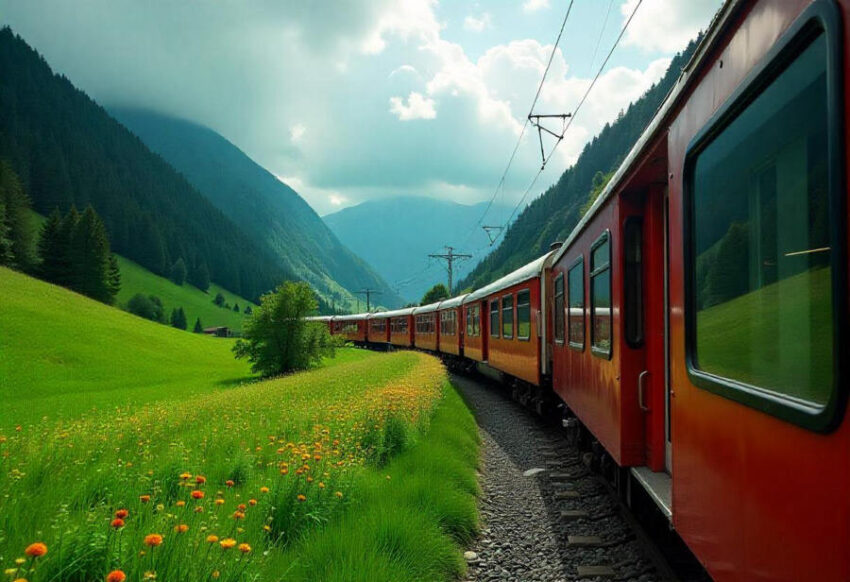Indian Railways Proposes A Groundbreaking Approach To Infrastructure With Dual-Purpose Rail And Road Tunnels, Promising To Streamline Connectivity And Reduce Construction Costs
Indian Railways has unveiled an innovative plan to revolutionize transportation infrastructure by proposing dual-purpose rail and road tunnels, a move aimed at enhancing connectivity while cutting down construction costs.
Indian Railways has unveiled an innovative plan to revolutionize transportation infrastructure by proposing dual-purpose rail and road tunnels, a move aimed at enhancing connectivity while cutting down construction costs. This groundbreaking approach will enable both rail and road traffic to share the same tunnel space, significantly improving efficiency by reducing the need for separate, costly constructions. By optimizing land use and accelerating transportation linkages, these tunnels promise to streamline travel across the country, boosting economic activities and providing faster, safer routes. This proposal highlights Indian Railways’ commitment to pioneering sustainable and cost-effective infrastructure solutions, catering to the growing demand for modern, integrated transport networks.
Indian Railways is embarking on an ambitious project to evaluate the feasibility of integrating both railway and vehicular traffic within the same tunnels. This is part of a broader vision to improve infrastructure in the country and address the increasing demand for efficient transportation networks. The tunnels for which alignments are still pending approval could potentially accommodate both types of traffic, optimizing space and minimizing the environmental and economic impact of constructing separate tunnels for each mode of transport.
The process for evaluating this integration is still in its early stages, and the decision to proceed will be contingent on a thorough investigation into various factors such as safety, cost, engineering feasibility, and the overall impact on traffic flow. According to those familiar with the plans, the Railway Board has directed all relevant agencies involved in the project to comply with specific guidelines and protocols during the alignment finalization and detailed project report (DPR) stages for the rail and road tunnel projects. These reports are critical for determining the precise parameters of the project, as they will include detailed technical specifications, financial assessments, and environmental considerations that must be taken into account before proceeding.
Once these reports are prepared, the proposals for the tunnel projects will be submitted to a joint working group (JWG) for further evaluation. This working group will consist of representatives from multiple departments, including those responsible for both road and rail infrastructure. The formation of such a group is a critical step toward ensuring collaboration between different sectors and facilitating a holistic approach to planning and execution. This joint effort will allow for an integrated strategy that aims to optimize the use of public resources and achieve cost-effective solutions for tunnel construction.
The emphasis on collaboration and shared resources reflects a broader governmental focus on promoting integrated planning. The integration of road and rail systems within tunnels is seen as an innovative approach that could help address the increasing congestion on both roadways and rail lines. By optimizing the use of available space, such projects could reduce the need for large-scale land acquisition, which often leads to high costs and environmental concerns. Additionally, this approach could lead to more efficient transportation systems, with both road and rail users benefiting from a single, shared infrastructure.
One of the main goals of this initiative is to foster cost-effective implementation. Tunnel construction is notoriously expensive, and the integration of multiple modes of transportation within a single tunnel could significantly reduce the overall cost of such projects. Rather than building separate tunnels for each system, this integrated approach could allow for shared infrastructure, which could lower both construction costs and maintenance expenses over time. The integrated nature of the project could also streamline regulatory processes and reduce the time required for approvals and project completion.
This development comes amid a broader push by the Indian government to improve the nation’s infrastructure. For the current year, the government has earmarked a significant ₹11.21 lakh crore for infrastructure spending, underscoring the country’s commitment to modernizing its transportation and communication networks. Of this massive sum, ₹32,235.24 crore has been allocated specifically for the development of new railway tracks. Another ₹2,169 crore will be dedicated to the construction of bridges, tunnels, and other critical infrastructure needed to support the growing rail network.
The government’s focus on infrastructure development extends beyond just railways. As part of its broader vision for national development, the Ministry of Roads has also committed to an ambitious infrastructure plan that involves building 50,000 kilometers of access-controlled highways over the next 10 to 12 years. This initiative is part of the larger ‘Viksit Bharat’ plan, which aims to transform India into a developed nation by addressing key infrastructural gaps. The total investment required for these highway projects is expected to exceed ₹20 lakh crore, marking one of the largest infrastructure undertakings in the country’s history.
The integration of rail and road tunnels is just one part of a much larger infrastructure development effort in India. By improving connectivity between different modes of transportation, the government hopes to streamline the flow of goods and passengers across the country, making travel more efficient and reducing overall transportation costs. This approach also supports the government’s focus on sustainability and reducing the environmental impact of infrastructure projects, which is becoming an increasingly important consideration in the planning of such projects.
Indian Railways’ proposal for dual-purpose rail and road tunnels aims to improve connectivity and reduce construction costs by allowing both types of traffic to share the same infrastructure, optimizing land use and accelerating transportation linkages.
the Indian Railways is exploring the potential of integrated rail and road tunnels as part of an ambitious infrastructure development initiative. With an allocation of funds for railway tracks and tunnels, as well as the government’s commitment to building extensive highway networks, this initiative is an essential part of India’s long-term vision for modernizing its transportation systems. The collaborative approach between the Ministry of Railways and the Ministry of Roads, coupled with the emphasis on cost-effectiveness and integrated planning, is expected to make these tunnel projects an innovative solution for the country’s growing transportation needs. As these plans move forward, the successful integration of rail and road networks within tunnels could set a new precedent for infrastructure development in India and beyond.
The post Indian Railways Proposes A Groundbreaking Approach To Infrastructure With Dual-Purpose Rail And Road Tunnels, Promising To Streamline Connectivity And Reduce Construction Costs appeared first on Travel and Tour World


Comments and Responses
Please login. Only community members can comment.